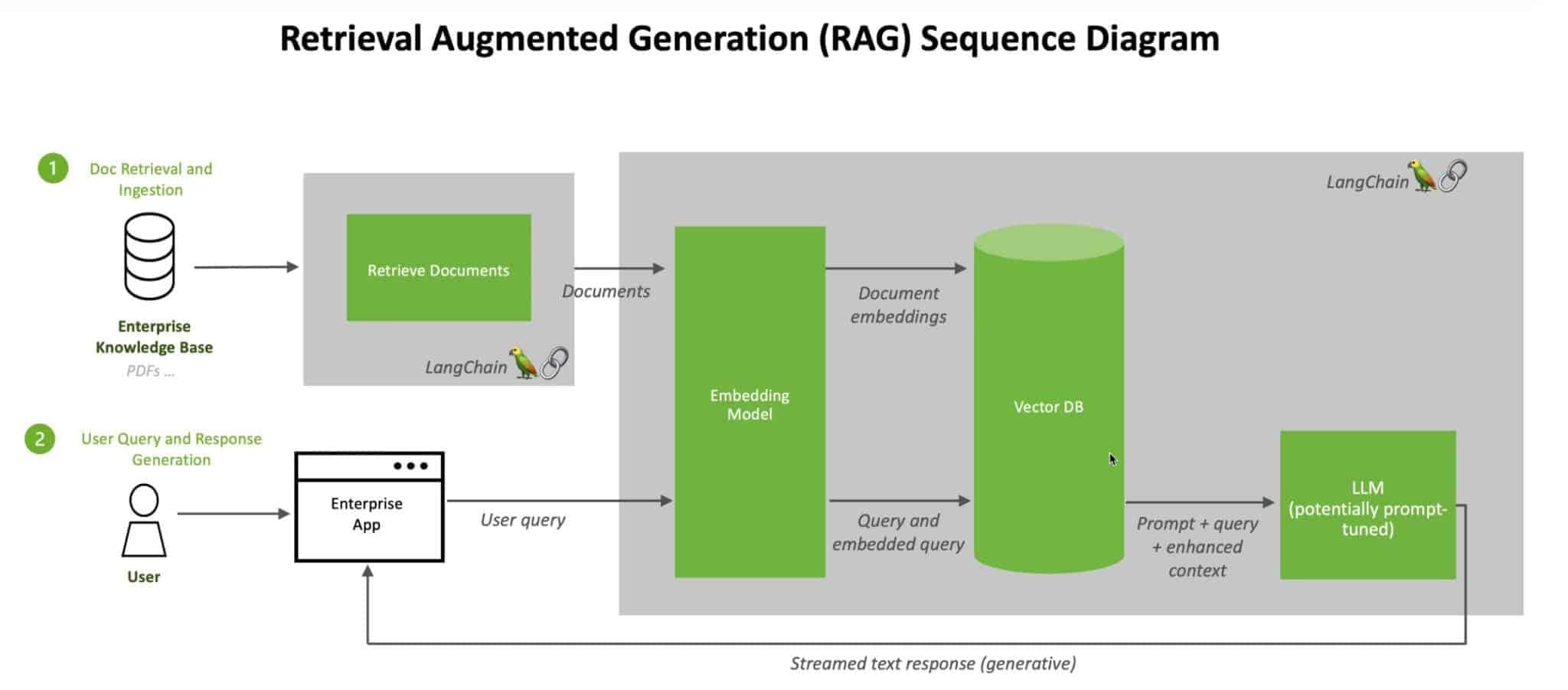How to use Vector Databases with Retrieval Augmented Generation (RAG) for Powerful LLM Apps
Large language models (LLMs) have emerged as powerful tools for enterprise looking to implement natural language processing (NLP). LLMs, such as GPT-4, Claude, and Llama 3 have demonstrated remarkable capabilities in understanding and generating human-like text. However, despite their impressive performance, LLMs often struggle with context awareness and accuracy, especially when dealing with domain-specific information.
To address these challenges, researchers and developers have turned to innovative techniques like Retrieval Augmented Generation (RAG) and vector databases. RAG enhances LLMs by allowing them to access and retrieve relevant information from external knowledge bases, while vector databases provide an efficient and scalable solution for storing and querying high-dimensional data representations.
In this blog post, we will explore the transformative potential of combining vector databases and RAG for building powerful LLM applications. By leveraging the synergy between these technologies, we can create AI systems that are more accurate, context-aware, and capable of handling diverse domain-specific tasks.
The Synergy between Vector Databases and RAG
Vector databases and RAG form a powerful synergy that enhances the capabilities of large language models. At the core of this synergy lies the efficient storage and retrieval of knowledge base embeddings. Vector databases are designed to handle high-dimensional vector representations of data. They enable fast and accurate similarity search, allowing LLMs to quickly retrieve relevant information from vast knowledge bases.
By integrating vector databases with RAG, we can create a seamless pipeline for augmenting LLM responses with external knowledge. When an LLM receives a query, RAG can efficiently search the vector database to find the most relevant information based on the query’s embedding. This retrieved information is then used to enrich the LLM’s context, enabling it to generate more accurate and informative responses in real-time.

Benefits of combining vector databases and RAG
Combining vector databases and RAG offers several significant benefits for large language model applications:
Improved accuracy and reduced hallucinations
One of the primary benefits of combining vector databases and RAG is the significant improvement in the accuracy of LLM responses. By providing LLMs with access to relevant external knowledge, RAG helps reduce the occurrence of “hallucinations” – instances where the model generates inconsistent or factually incorrect information. With the ability to retrieve and incorporate domain-specific information from reliable sources, LLMs can produce more accurate and trustworthy outputs.
Scalability and performance
Vector databases are designed to scale efficiently, allowing them to handle large volumes of high-dimensional data. This scalability is crucial when dealing with extensive knowledge bases that need to be searched and retrieved in real-time. By leveraging the power of vector databases, RAG can perform fast and efficient similarity searches, enabling LLMs to generate responses quickly without compromising on the quality of the retrieved information.
Enabling domain-specific applications
The combination of vector databases and RAG opens up new possibilities for building domain-specific LLM applications. By curating knowledge bases specific to various domains, LLMs can be tailored to provide accurate and relevant information within those contexts. This enables the development of specialized AI assistants, chatbots, and knowledge management systems that can cater to the unique needs of different industries and use cases.
The synergy between vector databases and RAG is transforming the way we build and deploy large language model applications. By harnessing the power of efficient knowledge retrieval and context-aware response generation, we can create AI systems that are more accurate, scalable, and adaptable to diverse domains. In the following sections, we will explore the implementation details and best practices for combining vector databases and RAG effectively.
Implementing RAG with Vector Databases
To harness the power of combining vector databases and RAG, it’s essential to understand the implementation process. Let’s explore the key steps involved in setting up a RAG system with a vector database.
A. Indexing and storing knowledge base embeddings
The first step is to process and store the knowledge base embeddings in the vector database. This involves converting the text data from the knowledge base into high-dimensional vectors using techniques like word embeddings or sentence embeddings. Popular embedding models, such as BERT, can be used for this purpose. Once the embeddings are generated, they are indexed and stored in the vector database, allowing for efficient similarity search and retrieval.
B. Querying the vector database for relevant information
When an LLM receives a query, the RAG system needs to retrieve relevant information from the vector database. To achieve this, the query itself is transformed into a vector representation using the same embedding model used for the knowledge base. The vector database then performs a similarity search, comparing the query vector with the stored knowledge base embeddings. The most similar embeddings, based on a chosen similarity metric (e.g., cosine similarity), are retrieved and used to augment the LLM’s context.
C. Integrating retrieved information into LLM responses
Once the relevant information is retrieved from the vector database, it needs to be integrated into the LLM’s response generation process. This can be done by concatenating the retrieved information with the original query or using more sophisticated techniques like attention mechanisms. The LLM then generates a response based on the augmented context, incorporating the retrieved knowledge to provide more accurate and informative answers.
D. Choosing the right vector database for your application
Selecting the appropriate vector database is crucial for the success of your RAG implementation. Factors to consider include scalability, performance, ease of use, and compatibility with your existing technology stack.
When choosing a vector database, it’s essential to evaluate your specific requirements, such as the size of your knowledge base, the expected query volume, and the desired response latency. By selecting the right vector database, you can ensure optimal performance and scalability for your RAG-enabled LLM application.
Best Practices and Considerations
To ensure the success of your RAG implementation with vector databases, there are several best practices and considerations to keep in mind.
Optimizing knowledge base embeddings for retrieval
The quality of the knowledge base embeddings plays a crucial role in the effectiveness of the RAG system. It’s important to experiment with different embedding models and techniques to find the most suitable representation for your specific domain and use case. Fine-tuning pre-trained embedding models on domain-specific data can often yield better results. Additionally, regularly updating and expanding the knowledge base embeddings as new information becomes available can help maintain the relevance and accuracy of the retrieved context.
Balancing retrieval speed and accuracy
When implementing RAG with vector databases, there’s often a trade-off between retrieval speed and accuracy. While retrieving more relevant information can improve the quality of the LLM’s responses, it may also increase the latency of the system. To strike the right balance, consider techniques like approximate nearest neighbor search, which can significantly speed up the retrieval process while maintaining acceptable accuracy levels. Additionally, caching frequently accessed embeddings and implementing load balancing strategies can help optimize performance.
Ensuring data security and privacy
As with any AI system that handles sensitive information, data security and privacy are paramount when implementing RAG with vector databases. It’s crucial to establish secure data storage and access controls to prevent unauthorized access to the knowledge base embeddings. Encryption techniques, such as homomorphic encryption, can be employed to protect sensitive data while still enabling similarity search operations. Moreover, regular security audits and adherence to relevant data protection regulations (e.g., GDPR, HIPAA) are essential to maintain the integrity and confidentiality of the system.
Monitoring and maintaining the system
Continuously monitoring and maintaining the RAG system is vital for ensuring its long-term performance and reliability. Regularly monitoring metrics such as query latency, retrieval accuracy, and system resource utilization can help identify potential bottlenecks and optimize the system accordingly. Implementing automated monitoring and alerting mechanisms can aid in proactively detecting and addressing any issues that may arise. Additionally, establishing a robust maintenance schedule, including regular backups, software updates, and performance tuning, can help keep the system running smoothly and efficiently.
By following these best practices and considerations, you can maximize the potential of combining vector databases and RAG for your large language model applications, ensuring a secure, scalable, and high-performing system that delivers accurate and context-aware responses.
Future Outlook and Potential for LLMs, RAG, and Vector Databases
As the field of artificial intelligence continues to evolve at a rapid pace, the combination of vector databases and RAG is poised to play a significant role in shaping the future of large language model applications.
Ongoing research and development in vector database technologies promise to bring even more powerful and efficient solutions for storing and retrieving high-dimensional data. Advances in indexing algorithms, compression techniques, and distributed computing will enable vector databases to handle ever-increasing volumes of data while maintaining high performance and scalability.
As vector databases and RAG continue to mature and find applications across various industries, they hold immense potential to drive innovation, automate complex tasks, and unlock new possibilities in AI-driven decision-making. By staying at the forefront of these technological advancements, organizations can gain a competitive edge and harness the power of large language models to solve real-world challenges.
Harnessing the Power of Vector Databases and RAG in Your Enterprise
As AI continues to shape our future, it is crucial for your enterprise to stay at the forefront of these technological advancements. By exploring and implementing cutting-edge techniques like vector databases and RAG, you can unlock the full potential of large language models and create AI systems that are more intelligent, adaptable, and provide greater ROI.






